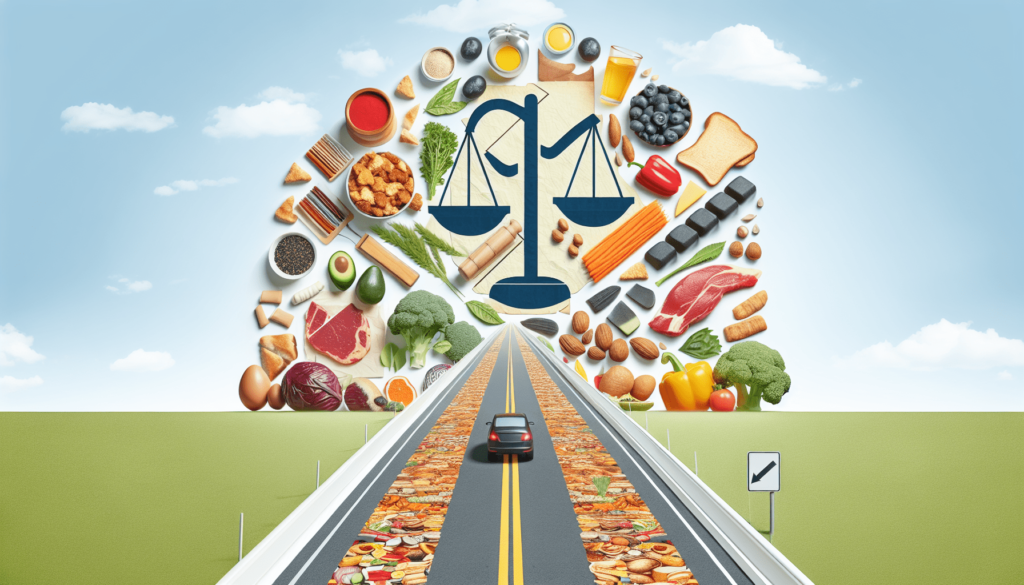You’re about to embark on a journey that will demystify the world of keto diets. In this article, we’ll guide you through the ins and outs of the Keto Diet 101, providing you with a comprehensive understanding of the basics and beyond. From debunking misconceptions to outlining the benefits and potential challenges, we’ve got you covered. Whether you’re a beginner looking to adopt a healthier lifestyle or a seasoned keto enthusiast seeking further knowledge, this article will equip you with all the essential information you need to navigate the fascinating world of the keto diet.

What is the Keto Diet?
The Keto Diet, short for the Ketogenic Diet, is a low-carbohydrate, high-fat diet that has gained popularity in recent years. It focuses on drastically reducing your carbohydrate intake and replacing it with fats. This dietary approach aims to put your body in a state of ketosis, where it predominantly burns fat for fuel instead of carbohydrates.
Definition
The Keto Diet is characterized by its low-carbohydrate, high-fat, and moderate protein intake. The typical macronutrient breakdown for this diet is 70-75% of calories from fat, 20-25% of calories from protein, and 5-10% of calories from carbohydrates.
How it Works
When you consume a high amount of carbohydrates, your body primarily uses glucose as its main source of energy. However, by severely restricting your carbohydrate intake, your body is forced to find an alternative fuel source. This leads to the production of ketones, which are molecules produced by breaking down fat in the liver. These ketones then become your body’s primary source of energy, effectively putting you in a state of ketosis.
Principles of the Keto Diet
The Keto Diet operates on a few key principles. Firstly, it restricts the consumption of carbohydrates to a minimal amount, usually around 20-50 grams per day. Secondly, it promotes the consumption of healthy fats, which are necessary to achieve ketosis. Lastly, it emphasizes the importance of moderate protein intake, as consuming excessive amounts of protein can hinder the body’s ability to enter or maintain ketosis.
Benefits of the Keto Diet
The Keto Diet offers several potential benefits beyond weight loss. Let’s explore some of these benefits further:
Weight Loss
One of the main reasons people turn to the Keto Diet is for weight loss. By reducing your intake of carbohydrates, your body is forced to burn fat for energy, leading to weight loss. Additionally, the high-fat content of the diet helps promote feelings of fullness, which can potentially reduce calorie consumption.
Improved Focus and Mental Clarity
Another benefit of the Keto Diet is improved cognitive function. Some studies suggest that when your body is in ketosis, your brain can efficiently use ketones as a fuel source, which may enhance mental clarity and focus.
Increased Energy Levels
Many individuals on the Keto Diet report increased energy levels. This can be attributed to the body’s efficient utilization of ketones as a source of fuel. Unlike carbohydrates, which can cause energy spikes and crashes, ketones provide a more stable and sustained energy source.
Foods to Eat on the Keto Diet
Adhering to the Keto Diet requires careful consideration of the foods you consume. Here are some key food groups that are commonly included in the diet:
Healthy Fats
Healthy fats play a crucial role in the Keto Diet by providing the majority of your daily calorie intake. These fats can come from sources such as avocados, olive oil, coconut oil, nuts, and seeds. Incorporating healthy fats into your meals is essential for maintaining ketosis.
Proteins
Proteins are an important component of the Keto Diet as they help repair and build tissues in the body. Opt for lean sources of protein such as chicken, turkey, fish, and tofu. It’s important to note that excessive protein intake can potentially hinder ketosis, so it’s essential to consume proteins in moderation.
Low Carbohydrate Vegetables
While the Keto Diet restricts carbohydrates, it’s still important to include non-starchy vegetables in your meals. These vegetables, such as broccoli, spinach, kale, and cauliflower, are low in carbohydrates but high in essential vitamins and minerals.
Nuts and Seeds
Nuts and seeds are nutritious and convenient snacks for those following the Keto Diet. Almonds, walnuts, chia seeds, and flaxseeds are excellent choices as they contain healthy fats and protein while being low in carbohydrates.
Dairy Products
Dairy products can be incorporated into the Keto Diet, but it’s important to choose full-fat options. Options such as butter, heavy cream, cheese, and full-fat yogurt are suitable choices to help meet your fat intake goals.
Foods to Avoid on the Keto Diet
To achieve and maintain a state of ketosis, it’s important to avoid certain foods. Let’s take a look at some key food groups to steer clear of:
Highly Processed Foods
Highly processed foods, such as chips, crackers, sugary cereals, and packaged snacks, should be avoided on the Keto Diet. These foods are usually high in carbohydrates, unhealthy fats, and added sugars, making them incompatible with a low-carb, high-fat approach.
Grains and Starches
Grains and starches are carbohydrate-rich foods that should be limited or avoided on the Keto Diet. This includes wheat, rice, oats, corn, and starchy vegetables like potatoes and peas.
Sugary Foods and Beverages
Sugary foods and beverages are not compatible with the Keto Diet due to their high carbohydrate content. This includes candies, cakes, cookies, sodas, fruit juices, and even some alcoholic beverages.
Fruits
While fruits are generally considered healthy, they can be high in natural sugars, making them incompatible with the Keto Diet. Fruits such as bananas, grapes, and oranges should be limited or avoided, while small portions of berries can be consumed in moderation.

Potential Side Effects of the Keto Diet
While the Keto Diet offers numerous benefits, it’s important to be aware of potential side effects, especially during the initial adjustment period. Here are some common side effects:
Keto Flu
During the initial phase of transitioning into ketosis, some individuals experience what is known as the “keto flu.” Symptoms can include fatigue, irritability, dizziness, nausea, and headaches. These symptoms are often temporary and can be mitigated by staying hydrated and ensuring adequate electrolyte intake.
Digestive Issues
Changing your diet dramatically can sometimes lead to digestive issues such as constipation or diarrhea. This can be attributed to the drastic reduction in fiber intake from carbohydrates. To prevent or alleviate these issues, it’s important to consume fiber-rich, low-carbohydrate vegetables and consider adding a fiber supplement if necessary.
Nutrient Deficiencies
The Keto Diet may lead to deficiencies in certain nutrients if not properly planned. Since the diet restricts certain food groups, it’s important to ensure you’re getting all the necessary vitamins and minerals. Consider including a variety of low-carbohydrate vegetables, sources of lean protein, and consulting a healthcare professional or registered dietitian to prevent any potential deficiencies.
Getting Started with the Keto Diet
If you’re interested in trying the Keto Diet, here are some important steps to help you get started:
Determining Your Macros
To follow the Keto Diet effectively, it’s crucial to determine your macronutrient needs. Calculate the specific amounts of fat, protein, and carbohydrates you should consume by using online calculators or consulting with a healthcare professional. This will guide your meal planning and ensure you’re on the right track.
Meal Planning
Meal planning is key to maintaining the Keto Diet successfully. Plan your meals and snacks in advance, ensuring they align with the macronutrient breakdown for the Keto Diet. This will help you stay organized, focused, and avoid making impulsive food choices that may derail your progress.
Tracking Your Progress
Monitoring your progress can be highly motivating on the Keto Diet. Keep track of your food intake, macronutrient ratios, and your weight or body measurements. This will allow you to gauge your progress and make any necessary adjustments along the way.
Tips for Success on the Keto Diet
To set yourself up for success on the Keto Diet, consider the following tips:
Stay Hydrated
Drinking enough water is crucial on the Keto Diet. Ketosis can cause increased water loss, so it’s important to stay properly hydrated. Aim to drink at least eight glasses of water per day, or more if you’re physically active.
Incorporate Variety in Your Meals
Eating a variety of foods ensures you get a wide range of nutrients while keeping meals interesting and enjoyable. Experiment with different healthy fats, proteins, and low-carbohydrate vegetables to diversify your meals and prevent monotony.
Don’t Be Too Restrictive
While it’s important to be mindful of your carbohydrate intake, being overly restrictive can hinder adherence to the Keto Diet. Allow yourself occasional indulgences or find keto-friendly alternatives for your favorite foods to help prevent feelings of deprivation.
Seek Support
Embarking on any new diet can be challenging, so it’s essential to seek support. Join online communities or find a diet buddy who can provide encouragement, share tips, and help you stay motivated on your Keto Diet journey.
Common Misconceptions about the Keto Diet
To dispel some common misconceptions, let’s address a few key points:
Keto is all about eating bacon and butter
While bacon and butter can be incorporated into the Keto Diet, the diet is not solely centered around these foods. A balanced Keto Diet focuses on a variety of healthy fats, proteins, and low-carbohydrate vegetables to ensure you’re meeting your nutritional needs.
The Keto Diet is only for weight loss
While weight loss is a common goal for those who adopt the Keto Diet, it offers benefits beyond just shedding pounds. The potential cognitive and energy-related benefits make it a suitable dietary approach for individuals looking to improve mental clarity and overall well-being.
It’s a high-protein diet
The Keto Diet is often mistaken for a high-protein diet, but it actually emphasizes moderate protein intake. Consuming excessive protein can hinder ketosis by converting excess protein into glucose through a process called gluconeogenesis. Proper balance among fats, proteins, and carbohydrates is crucial for the Keto Diet.
Is the Keto Diet Suitable for Everyone?
While the Keto Diet has gained popularity, it may not be suitable for everyone. Consider the following factors before starting:
Considerations for Specific Groups
Certain groups of individuals, such as pregnant or breastfeeding women, children, individuals with certain medical conditions, or those taking specific medications, should exercise caution or avoid the Keto Diet altogether. It’s best to consult with a healthcare professional before making any dietary changes.
Consulting a Healthcare Professional
Before starting the Keto Diet, it’s always a good idea to consult with a healthcare professional, such as a registered dietitian or a doctor. They can assess your individual needs, help you determine if the Keto Diet is suitable for you, and provide guidance throughout your journey.
Taking the Keto Diet Beyond the Basics
For those looking to explore variations of the Keto Diet, here are a few options:
Cyclical Keto Diet
The Cyclical Keto Diet involves alternating between periods of strict ketosis and higher-carbohydrate days. This approach is often utilized by athletes or individuals who require carbohydrates for specific activities or events.
Targeted Keto Diet
The Targeted Keto Diet allows for a small increase in carbohydrate intake around workouts. This can provide the necessary energy for intense physical activity while still maintaining ketosis for the rest of the day.
Restricted Keto Diet
The Restricted Keto Diet involves further restriction of carbohydrates and proteins. This approach may be recommended for individuals who have specific health concerns or require stricter ketosis for therapeutic purposes.
In conclusion, the Keto Diet is a low-carbohydrate, high-fat dietary approach that aims to put your body in a state of ketosis. It offers benefits such as weight loss, improved focus, and increased energy levels. By understanding the principles of the Keto Diet, knowing which foods to eat and avoid, being aware of potential side effects, and seeking professional guidance if needed, you can embark on a successful Keto Diet journey. Remember to stay hydrated, incorporate variety in your meals, and seek support to help you stay on track. While the Keto Diet may not be suitable for everyone, consulting with a healthcare professional can help you determine if it’s the right choice for you. Finally, exploring variations of the Keto Diet can provide additional options to suit your individual needs and goals.

